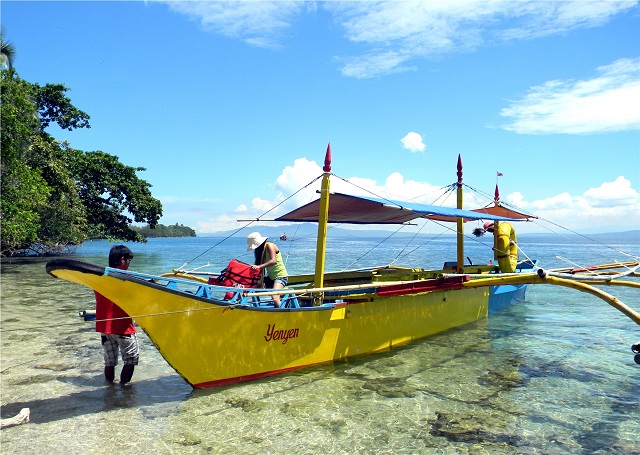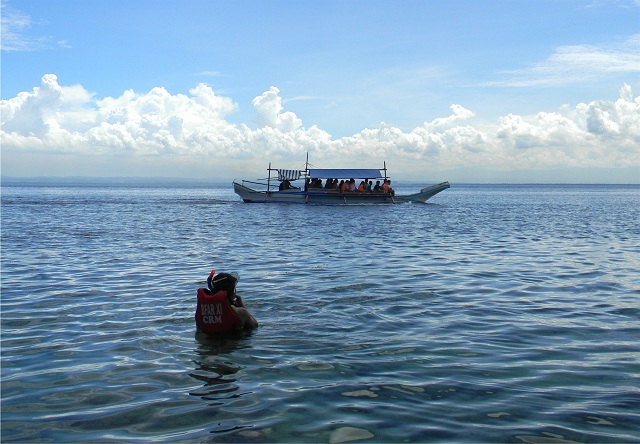Filtered by: Lifestyle
Lifestyle
Discovering Kopiat Island in the Davao Gulf
Text and photos by HENRYLITO D. TACIO
Off the Davao coast, Kopiat Island boasts of clear and calm waters and wide sections of shoreline blanketed with fine white sand.
It is a tranquil place that, once developed, could become a leading tourism destination in the region.
“Kopiat Island will put Compostela Valley on the tourism map,” Lucky Siegfred Balleque, the provincial project manager of the Department of Trade and Industry, told reporters last year after informing them that the DTI was negotiating with Lapanday Food Corporations and other owners for the development of the island into a world-class resort.

Touching down on Kopiat Island's pristine shore.
Traveling around the island takes about 20 minutes by motorized boat, while an inland tour of its 87 hectares takes about 45 minutes. A portion of the island encircles a seven-hectare lagoon.
Unknown to many, Kopiat hosts unspoiled reefs with rare coral beds that are home to exotic marine life. This was what we found out during our recent visit while attending the fifth Summer Beach Festival.
Christine T. Dompor, the provincial tourism officer, accompanied us on the island tour. She wanted us to enjoy its unspoiled beauty.
Just 200 meters away from the island’s shoreline, snorkelers can get close to the various species of colorful corals, both hard and soft. However, you can already get a glimpse of the beautiful corals just by looking down into the water from the boat.
“We are trying to protect these coral reefs from people who want to harvest them for aesthetic purposes in their homes,” Dompor said.
The Davao regional office of the Protected Areas and Wildlife Bureau of the Department of Environment and Natural Resources considers the coastal area of the island a wildlife habitat. The reason: It is a known breeding ground of marine turtles, a "protected and regulated" species.
Of the eight species of marine turtles known to man, five of them can be found in the Philippines: the green sea turtle (known in the science world as Chelonia mydas), the hawksbill (Eretmochelys imbricate), the loggerhead (Caretta caretta), the Olive Ridley (Lepidochelys olivacea), and the leatherback (Dermochelys coriacea).
All five are listed by the International Union for the Conservation of Nature and Natural Resources as endangered, and all can be found in Davao Gulf. Two species—the hawksbill and the leatherback turtle—lay their eggs on the Kopiat coast.

Unknown to many, Kopiat hosts unspoiled reefs with rare coral beds that are home to exotic marine life. This was what we found out during our recent visit while attending the fifth Summer Beach Festival.
Christine T. Dompor, the provincial tourism officer, accompanied us on the island tour. She wanted us to enjoy its unspoiled beauty.
Just 200 meters away from the island’s shoreline, snorkelers can get close to the various species of colorful corals, both hard and soft. However, you can already get a glimpse of the beautiful corals just by looking down into the water from the boat.
“We are trying to protect these coral reefs from people who want to harvest them for aesthetic purposes in their homes,” Dompor said.
The Davao regional office of the Protected Areas and Wildlife Bureau of the Department of Environment and Natural Resources considers the coastal area of the island a wildlife habitat. The reason: It is a known breeding ground of marine turtles, a "protected and regulated" species.
Of the eight species of marine turtles known to man, five of them can be found in the Philippines: the green sea turtle (known in the science world as Chelonia mydas), the hawksbill (Eretmochelys imbricate), the loggerhead (Caretta caretta), the Olive Ridley (Lepidochelys olivacea), and the leatherback (Dermochelys coriacea).
All five are listed by the International Union for the Conservation of Nature and Natural Resources as endangered, and all can be found in Davao Gulf. Two species—the hawksbill and the leatherback turtle—lay their eggs on the Kopiat coast.

Going snorkeling in the waters off Kopiat brings you close to the beautiful corals and rich marine life.
Although we were unlucky not to see marine turtles during our visit, Dompor reported that a week after the third Summer Beach Festival opened in 2011, they were able to rescue 21 hawksbill turtle hatchlings.
That incident encouraged Dompor to strongly push for the declaration of Kopiat Island as a turtle sanctuary and to make this a parallel project of the Summer Beach Festival, which is held annually to entice visitors to Compostela Valley’s beach resorts.
According to Dompor, she has made initial negotiations with Lapanday Food Corp.—which operates a portion of Kopiat Island—for a collaborative project geared towards protecting the sea turtles.
“We are practically concerned about conserving the breeding and hatching sites of the endangered hawksbill and leatherback turtles. In fact, the theme of our annual festival which is a joint project of the province’s resorts association is all about protecting the marine environment,” Dompor said.
Not far from Kopiat Island is the appropriately named Lunod Island: more than half of its 17 hectares is occupied by submerged mangrove forest teeming with beautiful sea creatures. Its rich coral gardens are spawning grounds for fish, crustaceans, and other marine life.
It takes about 15 minutes, by boat, to reach the island from the municipality of Mabini on the mainland. A night tour of the island is a wonderful experience, lit by the glittering fireflies that abound there.
Visiting both islands is currently really cheap. But once Kopiat Island is fully developed, it will be one of the best tourist island spots in the country. So don’t waste your time; visit Kopiat island now and experience the beauty of nature. — BM, GMA News
That incident encouraged Dompor to strongly push for the declaration of Kopiat Island as a turtle sanctuary and to make this a parallel project of the Summer Beach Festival, which is held annually to entice visitors to Compostela Valley’s beach resorts.
According to Dompor, she has made initial negotiations with Lapanday Food Corp.—which operates a portion of Kopiat Island—for a collaborative project geared towards protecting the sea turtles.
“We are practically concerned about conserving the breeding and hatching sites of the endangered hawksbill and leatherback turtles. In fact, the theme of our annual festival which is a joint project of the province’s resorts association is all about protecting the marine environment,” Dompor said.
Not far from Kopiat Island is the appropriately named Lunod Island: more than half of its 17 hectares is occupied by submerged mangrove forest teeming with beautiful sea creatures. Its rich coral gardens are spawning grounds for fish, crustaceans, and other marine life.
It takes about 15 minutes, by boat, to reach the island from the municipality of Mabini on the mainland. A night tour of the island is a wonderful experience, lit by the glittering fireflies that abound there.
Visiting both islands is currently really cheap. But once Kopiat Island is fully developed, it will be one of the best tourist island spots in the country. So don’t waste your time; visit Kopiat island now and experience the beauty of nature. — BM, GMA News
Tags: kopiatisland
More Videos
Most Popular




